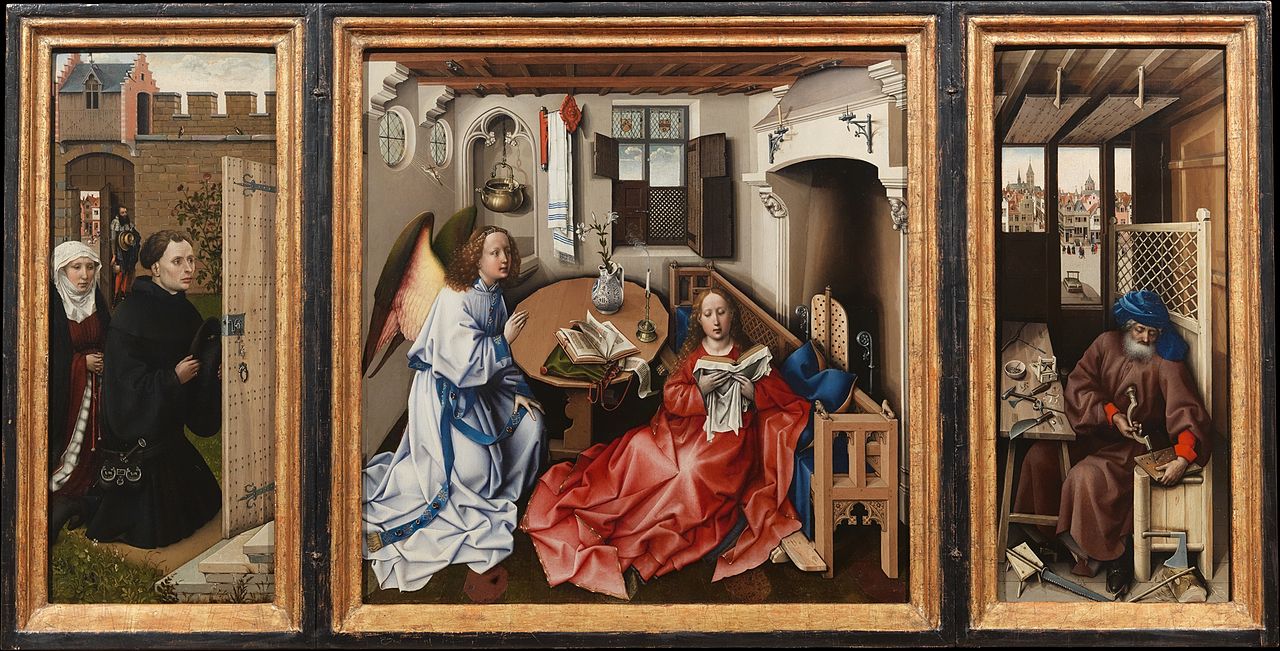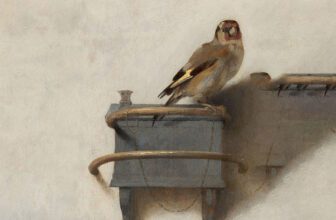
Meaning of Merode Altarpiece Painting by Robert Campin
In the quiet splendor of The Cloisters, a branch of the Metropolitan Museum of Art in New York, rests a painting that has captivated scholars, theologians, and art lovers for centuries. The Mérode Altarpiece, attributed to Robert Campin and his workshop around 1427–1432, stands as one of the earliest masterpieces of Early Netherlandish painting. At first glance, it might seem like a simple domestic scene infused with religious significance, but upon closer inspection, this triptych reveals a universe teeming with symbolism, theological nuance, and extraordinary artistic innovation.
This article unpacks the Mérode Altarpiece’s historical context, explores its iconography and symbolism, examines how it was painted and by whom, and reflects on its legacy in the canon of Western art.
What Is the Mérode Altarpiece?
The Mérode Altarpiece is a small, portable triptych, a three-paneled altarpiece, believed to have been commissioned by a private patron for personal devotion. It represents a pivotal moment in Christian theology: the Annunciation, the moment the Angel Gabriel announces to the Virgin Mary that she will conceive the Son of God.
The three panels are:
Left Panel: The donor and his wife (or possibly a prospective wife).
Center Panel: The Annunciation scene set in a Flemish domestic interior.
Right Panel: Saint Joseph, the carpenter, working in his workshop.
Painted in oil on oak wood, the triptych measures about 64 x 117 centimeters when open. Its small size suggests it was used for private devotion, not public worship. This intimacy allows the viewer to feel almost physically present in the unfolding narrative.
Who Painted the Mérode Altarpiece?
The Mérode Altarpiece is attributed to Robert Campin, often identified with the so-called “Master of Flémalle,” and is considered one of the pioneers of Early Netherlandish painting. While Campin was a highly respected painter in Tournai, much of his work is known only through attributions and association with his famous pupil, Rogier van der Weyden.
The painting is thought to have been created with the help of Campin’s workshop, possibly including van der Weyden himself as a young apprentice. Art historians base this on stylistic analysis, such as the use of detailed naturalism, mastery of oil paint, and the symbolic density of the imagery.
What Type of Art Is the Mérode Altarpiece?
The Mérode Altarpiece is a cornerstone of Early Northern Renaissance art and one of the earliest surviving examples of Flemish oil painting. It represents a shift from the flat, stylized forms of Gothic art to naturalistic detail and three-dimensional space.
This style emphasized:
Minute realism: Every fold of fabric, gleam of metal, and strand of hair is rendered with obsessive precision.
Oil paint: Campin was among the first to harness oil paint’s luminous and flexible properties.
Domestic setting: Sacred events are grounded in familiar, contemporary surroundings, a hallmark of Northern Renaissance art.
Symbolic integration: Everyday objects take on layered theological meanings.
The genre is often referred to as Christian devotional art or panel painting, distinguished by its intimate scale and private function.
What’s Happening in the Mérode Altarpiece?
Each panel is packed with narrative and visual meaning. Let’s examine each scene in detail:
Left Panel: The Donors
The left panel shows a well-dressed man and woman kneeling in a walled garden, symbolic of Mary’s purity (a hortus conclusus, or “enclosed garden”). The man, presumed to be the donor, looks into the center panel, drawing us into the sacred moment he commissioned.
Interestingly, the woman seems to have been added later, possibly indicating a marriage or changed circumstance during the painting’s commission. The gatekeeper in the background opens a door, symbolizing entry into the divine narrative.
Center Panel: The Annunciation
Here, the Virgin Mary sits on the floor beside a bench and a reading table, absorbed in a book, likely the Book of Hours or a psalter. The Archangel Gabriel kneels before her, just having arrived with divine news.
But look closely:
A tiny Christ Child carrying a cross flies through a ray of light toward Mary’s womb, signifying the Incarnation.
A lily in a vase on the table symbolizes purity and virginity.
A white towel, brass basin, and cleaning tools in the background suggest Mary’s cleanliness and spiritual preparation.
A snuffed-out candle may symbolize the moment when divine light replaces earthly light.
The open book is a sign of Mary’s piety and knowledge of Scripture.
This domestic interior grounds the sacred event in the everyday world of the viewer, making the miracle of the Incarnation more accessible and relatable.
Right Panel: Joseph’s Workshop
Joseph, often a background figure in earlier medieval art, is shown actively working on mousetraps. At first glance, this may seem mundane, but the symbolism runs deep.
Mousetraps were interpreted by theologians like Saint Augustine as metaphors for Christ’s humanity: a “trap” to ensnare the devil.
A wine press and tools evoke the Passion and the blood of Christ.
The window view reveals bustling city life and a marketplace, an intentional contrast to the spiritual stillness of the other panels.
This panel expands the narrative, showing how earthly labor, when aligned with divine purpose, can be sanctified.
Symbolism and Meaning in the Mérode Altarpiece
The Mérode Altarpiece is not just a visual retelling of the Annunciation; it is a theological treatise in paint. Every object is freighted with symbolic meaning:
1. The Enclosed Garden (Left Panel)
This walled garden symbolizes Mary’s virginity and her role as the new Eve. The concept of the “hortus conclusus” was widespread in Marian iconography.
2. The Lilies
These flowers represent Mary’s purity and her role as the unblemished vessel of the Incarnation.
3. The Book
Mary is reading the Scriptures, symbolizing her piety, wisdom, and acceptance of God’s word.
4. The Snuffed-Out Candle
This is one of the most discussed symbols. It may represent:
The extinguishing of the Old Law,
The presence of divine light replacing earthly light,
Or the moment of conception when human understanding is humbled by divine mystery.
5. The Mousetraps
This seemingly odd inclusion is theologically rich. As Saint Augustine wrote, Christ’s body is a trap for Satan, the devil takes the bait (Christ’s humanity), only to be defeated by His divinity.
6. The Architecture
The blend of Gothic and Romanesque elements symbolizes the transition from the Old to the New Covenant.
7. The Cross-Bearing Christ Child
This tiny figure flying in on a beam of light is a direct depiction of the moment of Incarnation, emphasizing Christ’s dual nature, divine and human, from the very start.
How Was the Mérode Altarpiece Painted?
Robert Campin’s use of oil paint was groundbreaking. Unlike tempera, which dries quickly and flattens details, oil allows for:
Layering and glazing, creating depth and luminosity.
Fine detail, such as the transparency of glass, the sheen of metals, and the texture of fabric.
Naturalistic modeling of forms, enhancing realism.
The painting was created on oak panels, primed with gesso. Campin would have sketched the design with a brush or stylus, then built up layers of paint, using pigments ground in oil, likely linseed or walnut.
Infrared reflectography has revealed underdrawings and changes, suggesting a dynamic and evolving creative process, typical of workshop production. Assistants may have contributed to less critical sections like the background or architectural elements.
Where Is the Mérode Altarpiece Now?
Today, the Mérode Altarpiece resides in The Cloisters, part of the Metropolitan Museum of Art in New York City. It is one of the museum’s most treasured pieces and is housed in a reconstructed medieval-style chapel room, providing a fitting contemplative atmosphere.
The painting was acquired in 1956 from the private collection of the Mérode family, from whom it gets its name.
Importance
The Mérode Altarpiece marks a turning point in Western art. It encapsulates a transitional moment between medieval symbolism and Renaissance humanism. In contrast to the monumental, formal representations of earlier religious art, this painting invites viewers into an intimate, domestic space, making the divine tangible.
Its innovations influenced an entire generation of artists, especially the Flemish Primitives like Jan van Eyck and Rogier van der Weyden. The meticulous detail, atmospheric realism, and profound symbolism helped shape the visual language of Christian narrative art for centuries.
Why the Mérode Altarpiece Still Matters
In an age of digital speed and fleeting images, the Mérode Altarpiece encourages stillness, observation, and meditation. It asks viewers to slow down, to look deeply, and to find the sacred in the ordinary.
By combining extraordinary realism with layered iconography, Robert Campin didn’t just illustrate the Annunciation, he invited the viewer to participate in it. Every object becomes a theological whisper. Every shadow, a mystery. Every detail, a doorway to wonder.
As we stand before this modest triptych in The Cloisters, we don’t just see a painting, we enter a story that, for many, still speaks with transcendent power.




